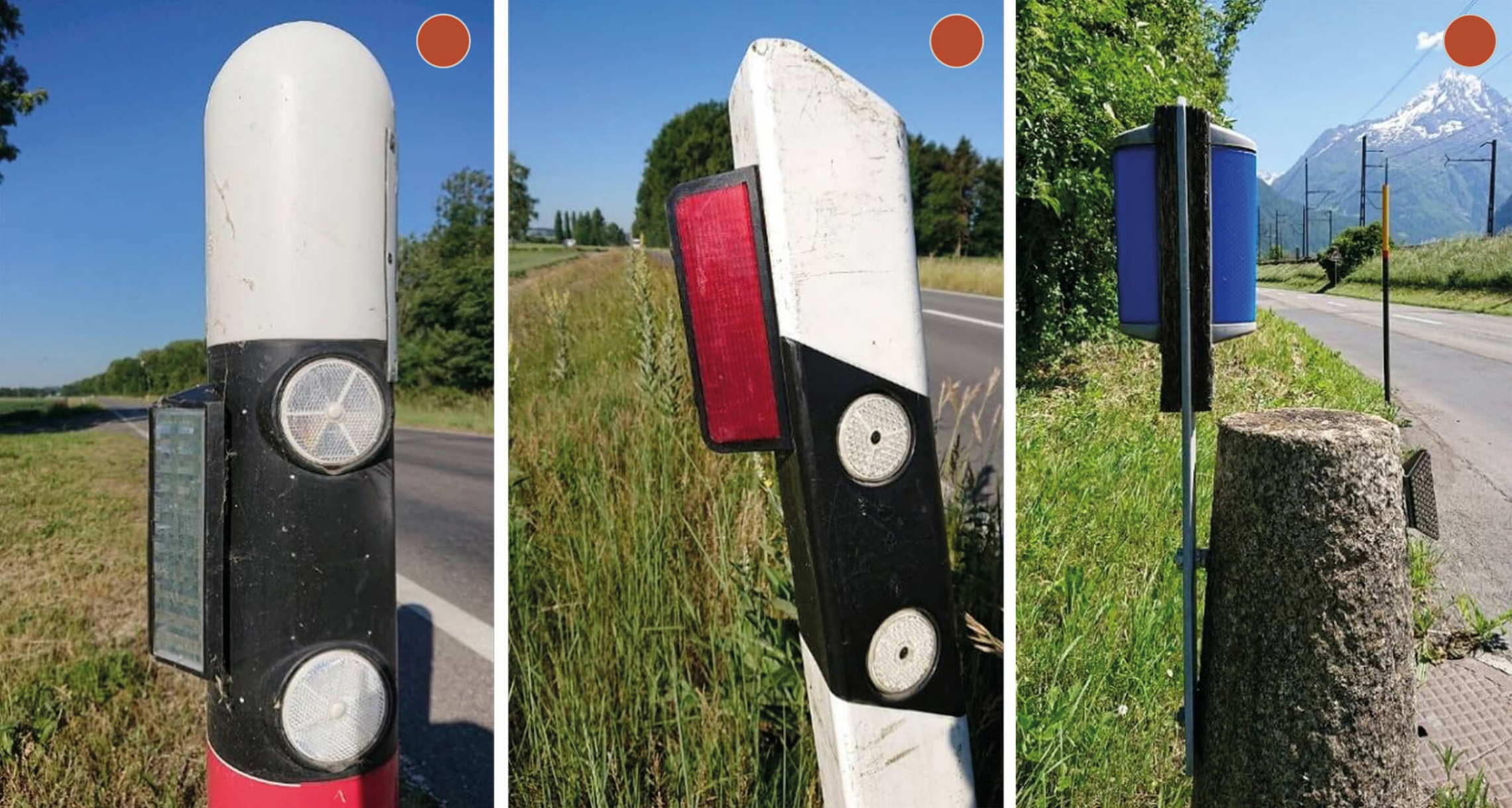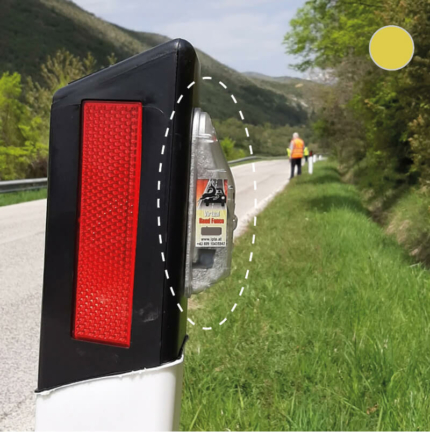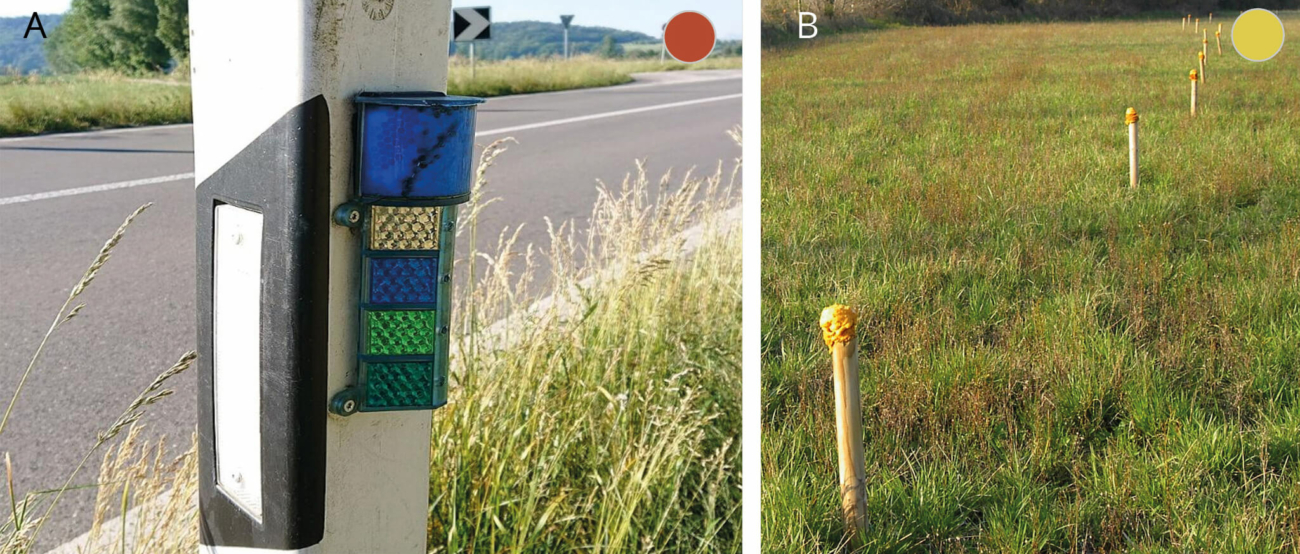RATIONALE. Wildlife deterrents
Wildlife deterrents in general are intended to cause fear or discomfort to animals and thereby induce a flight response or at least increased alertness. Various acoustic, visual and olfactory signals can be deployed to achieve this. Available evidence to date shows greater effectiveness of acoustic deterrents that rely on natural sounds over artificial, visual or olfactory cues. The challenge is to develop signals that are readily perceived and understood by wildlife.
Visual deterrents that either reflect or emit light when car headlights shine on them, have been installed widely, despite a lack of evidence about effectiveness. Several reviews revealed that reflectors have little or no effect in reducing wildlife-vehicle collisions (D’Angelo & van der Ree, 2015; Brieger et al., 2016, 2017; Kämmerle et al., 2017; Benten et al., 2018a, b, 2019). These authors also stated that effectiveness previously reported is mainly due to inappropriate study design, leading to potentially unreliable conclusions. Other reasons for this ineffectiveness are e.g., that the animals are unable to perceive the light being reflected (D’Angelo & van der Ree, 2015; Benten et al., 2019; Coulson & Bender, 2019), that the light is insufficiently intense and masked by the already illuminated road surface or roadside vegetation (Seiler et al., 2017), that animals can run onto the road to escape and also that they quickly become habituated (Ujvári et al., 2004; D’Angelo et al., 2006; Coulson & Bender, 2019). One major concern about visual cues is the lack of animal response to the standard headlights of vehicles that illuminate the road ahead.
Innovative acoustic deterrents are showing more promising results, especially those that use sounds with natural meaning, such as alarm calls from local species or human voices (Biedenweg et al., 2011; Babińska-Werka et al., 2015; Seiler & Olson, 2017; Coulson & Bender, 2019; Berndt, 2021; Bhardwaj et al., 2022a and references therein), and those that sound only when an actual threat is present in the form of an approaching vehicle (Babińska-Werka et al., 2015; Seiler & Olson, 2017; Lodnert, 2021). These features can improve the results also in the long-term by reducing or eliminating wildlife habituation, which is otherwise the main drawback of deterrents (Elmeros et al., 2011; Benten et al., 2018b).
Acoustic and visual stimuli may also be combined to produce a ‘virtual fence’ that are intended to deter animals from crossing roads or railways when vehicles approach at night. Evidence for the effectiveness of these combined approaches is still scarce and contradictory (Coulson & Bender, 2019; Englefield et al., 2019; Fox et al., 2019; Stannard et al., 2021) and more research is needed to determine their potential.
In general, studies on the sensory perception and flight behaviour of the target species should be conducted prior to extensive deployment of mitigation strategies (D’Angelo et al., 2006). Also, more knowledge is needed about the potential disturbance of wildlife deterrents to adjacent habitats.
Visual, acoustic, or olfactory devices are deployed to help prevent wildlife, often deer and wild boar, from crossing transport infrastructures or to increase their alertness to approaching vehicles. Development is very active in this field and many types of devices are available. However, so far, most methods have failed to provide convincing evidence of their effectiveness, while some (e.g., wildlife reflectors or vehicle-mounted whistles) are proven to be ineffective.
Some studies that show a reduction in the number of accidents are short-term and do not necessarily prove the effectiveness of such systems. Other reasons can also lead to a reduction in accidents, such as a decrease in animal population or a change in traffic volume.
Maintenance requirements are a determining factor as many of these devices require high maintenance and do not work if this is neglected (see Chapter 7 – Maintenance).
Wild animals, and particularly ungulates and large carnivore, may get used to these stimuli when they are recurrent and not associated with a perceived risk for the animal. This results in a loss of effectiveness over time. To reduce the risk of habituation, these prevention measures may be best deployed only during critical periods when most accidents occur or, preferably, only when vehicles approach.
Wildlife deterrents could also cause disturbance that may reduce the quality of adjacent habitats next to infrastructure.
Visual deterrents
Visual deterrents reflect or emit light, normally red, blue or white (Figure 5.4.1) and they are typically attached to delineators located at road verges.
Reflectors which bounce the lights of approaching vehicles into the surroundings are intended to alert animals, discouraging them from entering the road or scare them away. However, studies show that such lights are not perceived by target species or are too weak compared to the simultaneously illuminated road surface, side vegetation and delineator pole itself. The effectiveness of such devices must therefore be questioned (see Rationale box. Wildlife deterrents).
No long-term studies have so far been able to show a sustainable reduction in wildlife accidents where reflectors are deployed. In some cases, a reduction in animal vehicle accidents has been attributed not to any change in animal behaviour but to drivers cutting speed when they see reflected or emitted light, particularly blue, on the road verge. However, other studies do not show any reduction in speed.
Responsive acoustic and visual deterrentes
Currently available devices that incorporate acoustic deterrents are often attached to delineator poles and triggered by the light of an approaching vehicle or the presence of large animals detected by thermal cameras, movement sensors, or other systems (Figure 5.3.3). The devices emit an artificial whistling sound in a frequency audible to the animals that aims to discourage wildlife, mainly deer, from crossing the road or railway. However, there is yet no convincing evidence for the efficacy of these devices in reducing accident risks.
Similarly, so-called deer whistles, which are mounted on the vehicle and produce sound via the airflow are intended to scare deer away so that no collision occurs. However, the sound may be ineffective because it is outside the audible range of the animal or is drowned out by traffic noise.
Combined acoustic and visual deterrents, also known as ‘virtual fences’, are also increasingly installed. Attempts are made to reduce the habituation effect by making it possible to vary the sound frequency or colour of the light (Figure 5.4.2). Studies show contradictory results on effectiveness (see Rationale box. Wildlife deterrents).
Bio-acoustic approaches that, instead of a bell, chime or whistling sound, use a natural sound that animals associate with a real threat, such as human voices, dogs barking or a species-specific alarm show more promising results. Several studies show a strong flight response in deer and wild boar when human voices are emitted, but the effect may be context dependent. More studies, especially long-term monitoring, are needed to further develop and refine bio-acoustic systems to prevent animal-vehicle collisions.
Another method which has been proposed is a grooved or rippled road surface that produces a loud warning sound when vehicle wheels move over it. These sounds must be in the frequency range of target species for this to work. However, more detailed investigations are needed to verify its effectiveness and concerns about the impact of such a noise on the adjacent habitats have been raised.
Olfactory deterrents
Olfactory deterrents or so-called ‘scented fences’ are intended to keep wildlife away from crops and urban green spaces and they are also proposed as a method to prevent accidents on infrastructure (Figure 5.4.3). Synthetically produced fragrances which imitate human or predator scents are often deployed. These products should be used only during short critical periods because animals become readily habituated (see Rationale box. Wildlife deterrents).


